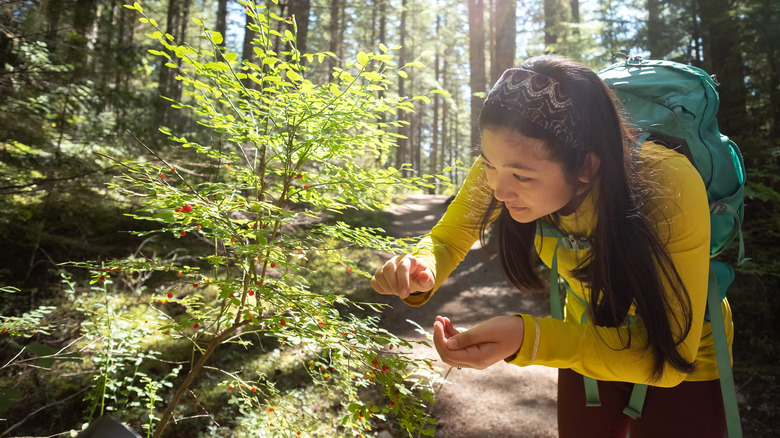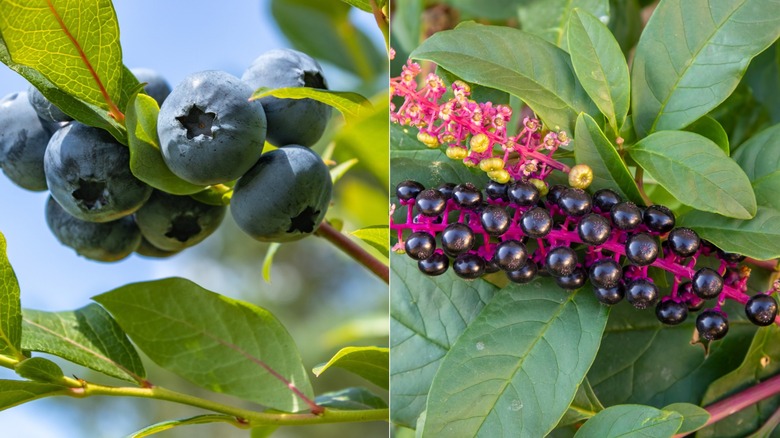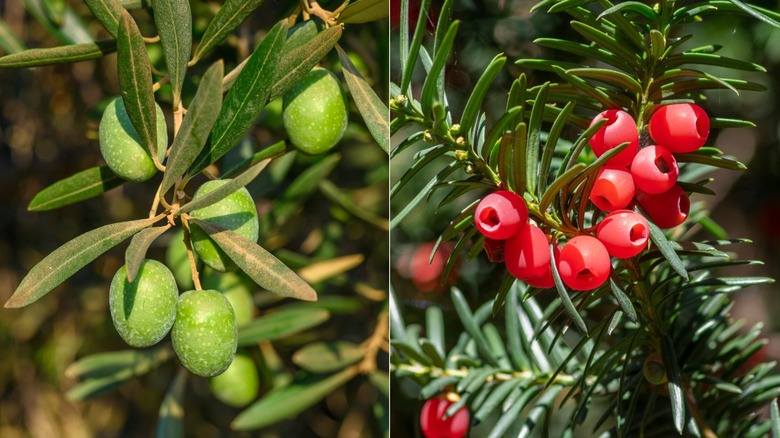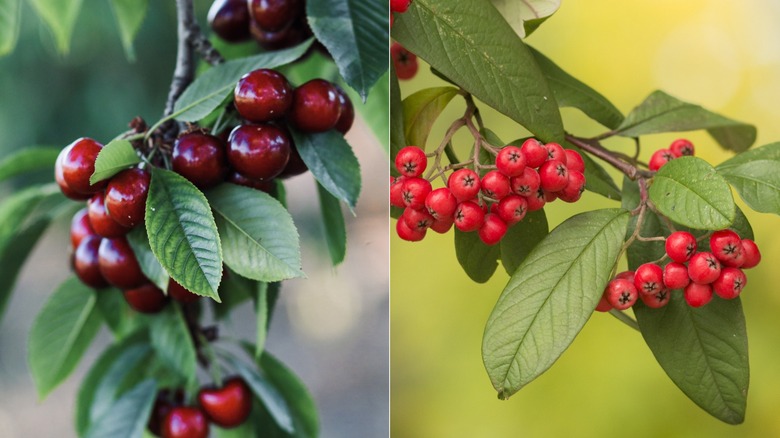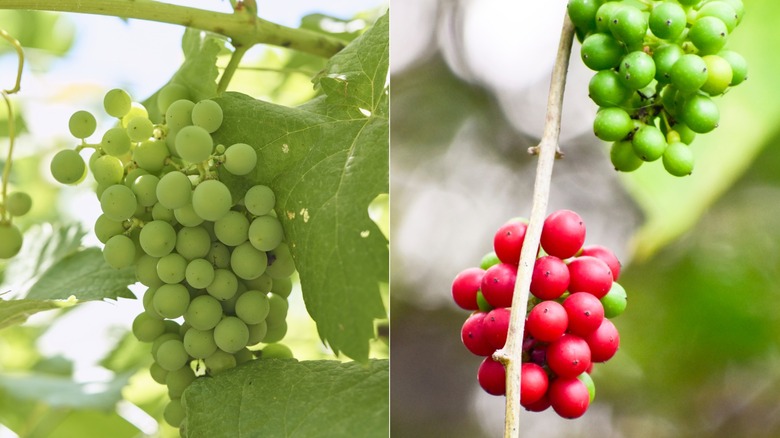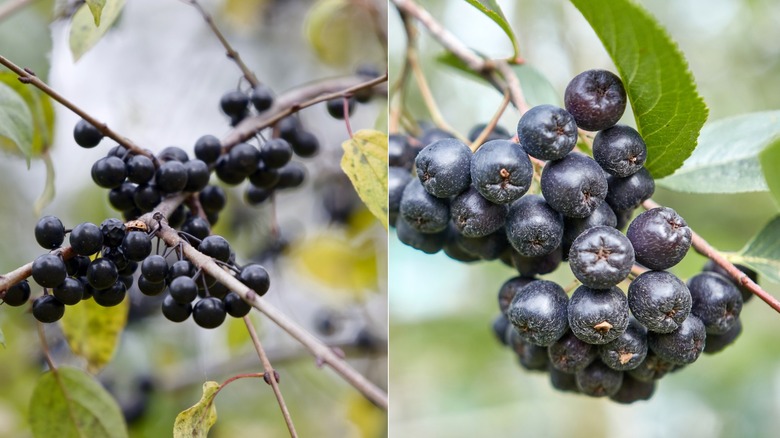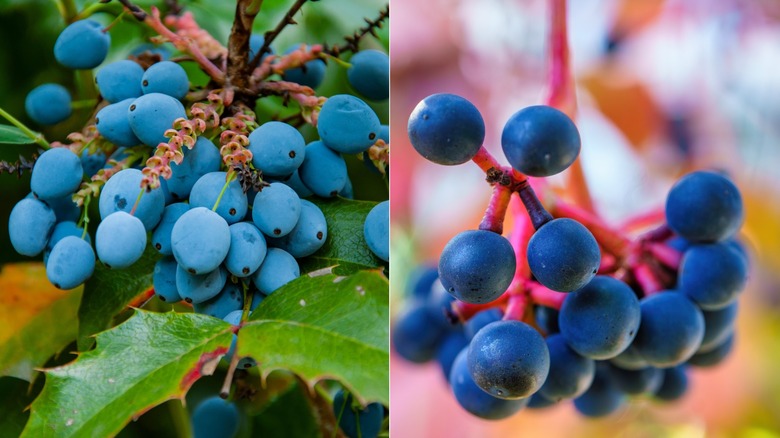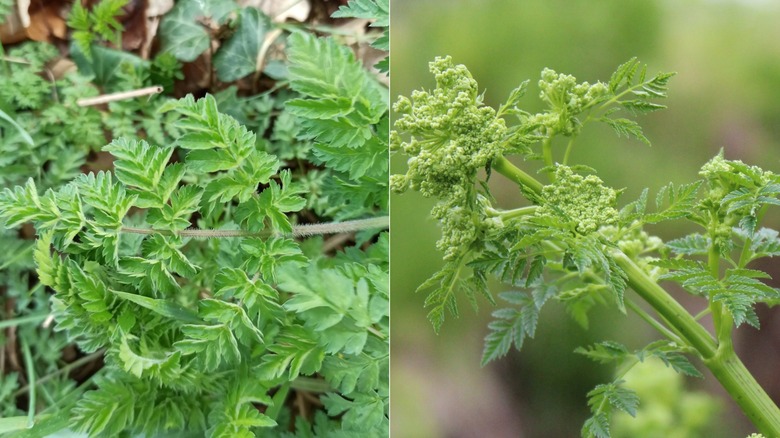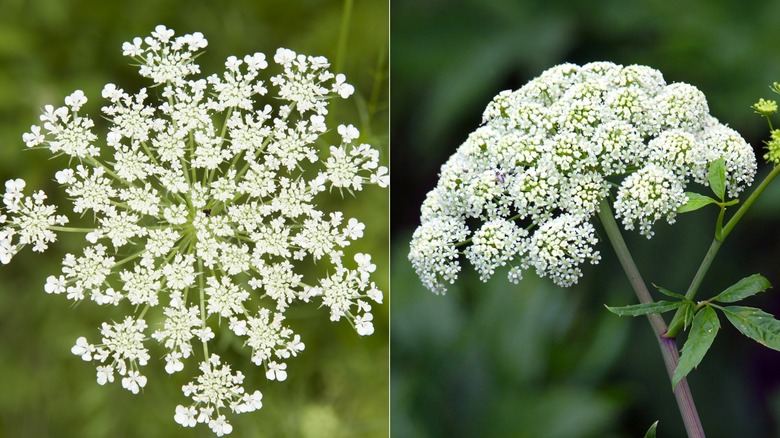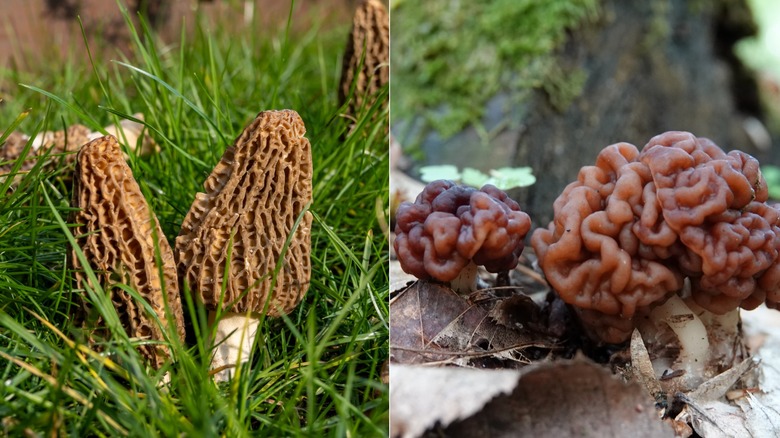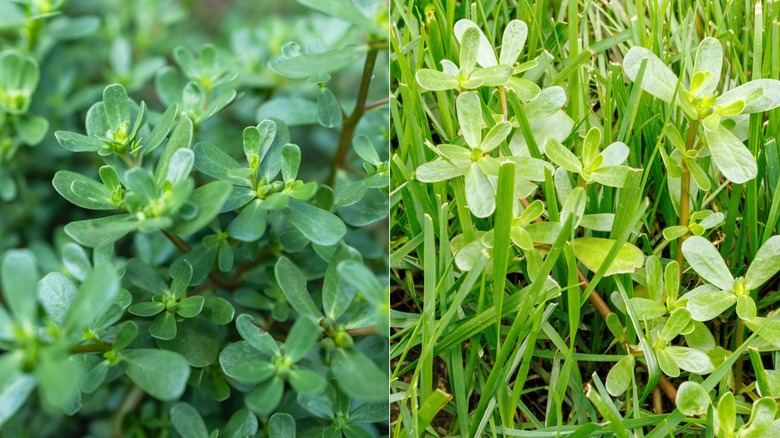How To Tell The Difference Between Common Edible Plants And Their Poisonous Look-Alikes
There are millions of plants on our planet, and inevitably, species from the same family end up looking alike. Wild plants aren't pre-labeled like produce found in a grocery store, and identifying them is a guessing game for the inexperienced. Be wary that many poisonous plants look very similar to harmless look-alikes found on hiking trails and in homegrown gardens.
Below are 12 toxic plants to be aware of so you don't mistake them for delicious, edible plants. Many fruits, herbs, and vegetables are from the moschatel, nightshade, and umbellifer families, meaning they have similar flowers, fruits, leaves, stems, or growing patterns. We compared the characteristics of especially similar plants, exploring how their appearance leads to common mix-ups. Even after seeing these images and reading the comparison, remember that the safest route is to ask for professional assistance before you start snacking. Fruits, herbs, and vegetables are hard to identify, especially when they aren't healthy and mature — diseases or malnutrition could make it harder to discern their true coloring and shape.
Elderberry cultivars vary by color
Gardeners love elderberry shrubs for their delicious fruit. You can identify them by their lance-shaped and toothed leaves that grow in groups of five to seven. In summer, they bloom with hundreds of tiny white flowers, and fruits appear in early fall. These fruits are either red or a dark purple and blue color. The flowers, leaves, and stems give off an ammonia-like smell when crushed, warning that none of these plant parts are edible. Although most of the plant is inedible, the berries are where it gets confusing.
The ornamental elderberry plants with red fruits are especially poisonous, and only elderberries with purple or deep blue fruits are considered edible. Even though they can be eaten, it's recommended to cook and properly prepare them to remove toxins and make them safe for consumption. The general consensus is that unripe fruits are more dangerous than ripe fruits. Fortunately, the difference in color makes distinguishing toxic cultivars from nontoxic ones easy.
Jerusalem cherries look like grape tomatoes
Jerusalem cherries are poisonous plants that look beautiful in gardens. But don't mistake their appealing appearance to mean they're edible. Although these fruits grow in the same shape and colors grape tomatoes do, they would be a poisonous addition to your garden salad. Jerusalem cherries grow on bushy evergreen shrubs with dark green lanceolate-shaped leaves. They bloom with clusters of flowers with white or light purple petals and yellow pistils in the springtime. Their fruits have a more spherical shape and have red, orange, and yellow coloring. These cherries appear in the late fall and winter, making them very different than most typical fruiting plants.
In contrast, safe-to-consume grape tomatoes branch off stems in vines with serrated leaves, though they are also a rich green color. They bloom with similar-shaped flowers, except they're completely yellow. The fruits are the same colors as Jerusalem cherries, though they are traditionally more oblong in shape. There can be some variance, as some harvests are more spherical than others. Grape tomatoes tend to grow at a very different time of year, popping up at any time between spring and early fall. Be warned that the cherries and tomatoes have a very similar flavor. This makes it imperative to identify the physical plant and not rely on a taste test to tell them apart.
Pokeweed berries grow in grape-like formations and look like blueberries
Of all the perennial plants you don't want to see in your yard, pokeweed should be at the top of your list. Seeing as all parts of the plants are toxic to people and commonly misidentified as blueberries, they aren't a good choice for home gardens. These plants have a thick red main stem that branches off into smaller stems with its fruits. They have medium- to large-size leaves with an oblong shape. Tiny petal-less flowers grow off short stems and come in shades of white, green, pink, and purple. The pokeweed berries, or pokeberries, look like blueberries but grow in grape-like formations in the late summer through fall.
Blueberries grow on shrubs that have a yellow-green stem color, though they turn red during the winter, which is when the confusion often begins. Keep in mind these plants won't stay red year-round like the pokeberries will. Blueberry plants' leaf shapes vary from elliptic to ovate with some contrast in the coloring between the top and bottom. Their flowers bloom in similar colors but have petals that form a bell shape and dangle downward. Blueberries often form fruits in early spring and summer, so they should appear before pokeberries have a chance to start showing up. Fortunately, pokeberries are not appetizing and you should be aware of your mistake shortly after tasting them.
Yew berries look like bright red Cerignola olives
Never mistake a yew berry for a wild red Cerignola olive growing in the wild. The No. 1 reason for this is that these olives don't even exist in the natural world — red Cerignola olives are dyed to be that rich red color. If you come across bright red fruits that look like these olives, they're likely yew berries. These berries grow on shrub-like plants with dark green, needle-like leaves that are surprisingly soft to the touch. The coloring of the foliage ranges from light green to a darker shade, depending on its age, and the aforementioned brightly colored fruits grow after the white and yellow globe-shaped flowers appear in spring.
Olive trees grow a lot taller and wider than yew trees, and you aren't likely to find any growing naturally in the United States. The leaves are an obovate shape, looking more like standard leaves with a slight difference in the upper and bottom colors. Their flowers are small and white and look nothing like yew tree flowers. As for the fruits, there is some variety in olive colors, especially because different cultivars have been bred over the years, but generally, they range between green, purple, and black. If you accidentally bite into a ripe yew berry, it'll taste sweet and almost like a lychee, informing you that it is not an olive.
Holly berries resemble tiny clusters of cherries
Holly berries are another deceptive fruit, taking on the guise of tiny cherries. These berries are only ¼ inch to ⅓ inch in size, meaning they're less than one-third of the size of cherries. Aside from the fruit size, you can identify American holly plants by the gray undertone in their stems and their thick glossy leaves with spiked edges. They have tiny pale green to white flowers in the late spring to early summer and usually don't start fruiting until the fall.
The first sign that you're looking at holly berries instead of cherries is if it's fall or early winter. Cherry trees don't fruit as late in the year, bearing fruit in spring or summer. Another way to tell the difference is by the aforementioned size difference. Cherries also grow on round, heart-shaped leaves, which also have serrated edges but look subtler and less severe. The bark can be slightly deceiving because some cherries also have a grayish undertone. In the end, holly berries aren't appetizing and are very bitter to taste. Don't make the mistake of thinking you're biting into a sour cherry — that should have a tart taste but not an unpleasant one.
Moonseed berries look like wild grapes at first glance
Moonseeds are native all across the eastern United States, and in many states, they share their land with wild grapes. While wild grapes are edible, moonseeds should be avoided at all costs. You can recognize these vines by their growth patterns. They either sprawl across a forest floor or wrap around other trees for support. Their leaves are shaped like stout maple leaves and have smooth edges in a standard green color. In the spring and summer, they bloom with tiny yellow or white spiky flowers before producing their grape-like fruits in the fall.
Although wild grapes grow in a similar formation, their vines have forked tendrils, while moonseed plants do not. Their leaves also look very different. Wild grape leaves are heart-shaped with serrated edges and raised veins on their green surface. These plants flower in the early growing season around the same time moonseeds do, but their flowers are clusters of bell-shaped green, white, or yellow bulbs. Depending on whether the plant is female or male, small pistils also stick out the center. As for the fruit, wild grapes produce fruit around the same time as moonseed berries, and their harvests are the same black and blue colors. However, if you disregard all these identifying factors and take a bite out of a moonseed berry, you'll know instantly it isn't a wild grape. Wild grapes are sour but palatable, while moonseed berries have an awful bitter taste.
The berries of common buckthorn have striking similarities to chokeberries
Common buckthorns are distinguished by their leaves, which have an elliptic shape, tiny teeth, and pointed tips. The flowers aren't very noticeable, but the fruits sprout in August and September. They form clusters like wild grapes but are only ¼ to ½ inch in size, making them the same size as blueberries. If you look closely, you'll see that buckthorn berries directly attach to the branch.
Chokeberries are a native berry shrub that attracts birds and makes a great addition to a home landscape, which already makes them vastly different from the invasive and weedy buckthorn. Their leaves are almost indistinguishable except chokeberries have notable serrated edges to them. They fruit in a dark blue or purple color, only slightly lighter than their poisonous look-alike, and they also pop up when fall rolls around. One of the only clear identifiers that sets apart these plants is that chokeberries grow in clusters attached to a branch, rather than affixing themselves directly to the branch. Beware that buckthorn is also commonly mistaken for other palatable fruits like blueberries, sand cherries, wild grapes, and black currants. It has the same toxic flavor as many other inedible fruits, but feeling poisonous effects takes eating about a handful of them.
Virginia creepers are another grape look-alike
Virginia creepers grow on the same red vine as pokeberries and should also be avoided for snacking purposes all the same. They're recognizable by their serrated obovate leaves, which sprout in groups of five, often leading to confusion with another notoriously toxic plant: poison ivy. The fruits often appear in late summer, after blueberries, but a little before wild grapes. They're about a half-inch long and range in color from blue to purple to black.
Although wild grapes have serrated leaves, they have a much more unique leaf shape than Virginia creepers because of their heart shape and textured veins. Wild grapes also have green and brown stems, meaning there shouldn't be rich lines of pink running up and down these vines. Don't risk biting into Virginia creeper fruits. They have tiny, sharp, needle-like surfaces that reportedly don't taste very good. The best course of action is to look for effective ways to kill any Virginia creeper that is taking over your yard.
Poison hemlock looks just like parsley except for its purple stems
Poison hemlock looks so much like a popular kitchen herb that it's earned the nickname "poison fool's parsley." Fortunately, parsley doesn't stick out as obviously as fruiting plants, and it's much less likely you'll accidentally take a bite from a random hemlock plant. Still, it's important to know that poison hemlock's leaves are very similar to those of parsley. Recognize poison hemlock plants in your yard by their hollow stems with red and purple discoloration across them. The leaves are triangular in shape and divided into smaller leaves with ruffled sides. The leaves are present year-round. During the growing season, they form clusters of tiny white flowers, followed by fruits shaped like plump anise that transform from green to brown as they age.
Parsley plants grow on thin green stems, and when healthy, they won't have any sign of discoloration. Their leaf shape is unusually similar to their poisonous counterpart's. However, when you crush parsley leaves, they may release a subtle scent. Their flowers aren't white but a yellow to pale green color. Parsley doesn't give off a strong odor, but when you crush hemlock, it gives off an ammonia-like smell.
Poison hemlock can be mistaken for wild carrots, but the flowers and stems have telltale differences
Poison hemlock takes the shape of another familiar kitchen staple: carrots. As mentioned previously, hemlock's serrated leaves grow in groups of two or three with a pointed tip, and their hollow stems have a mottled coloring. Their springtime bunches of white flowers are important to keep in mind as they're major culprits behind this plant mix-up.
Only the tops of wild carrots mimic water hemlock as they stick out above the soil, and they have many notable differences. A wild carrot stem is green to dark brown with tiny bristles up and down the sides. The foliage appears as a bunch of tiny leaves in sets of two and may be slightly lighter green than hemlock. One of the most deceiving characteristics is the white clusters of flowers, which appear on healthy wild carrots and are almost identical to their poisonous counterpart's. In the center of the clusters of flowers is a dark central dot, which helps set them apart. As mentioned, hemlock doesn't grow a fruit that looks similar to carrots. Eating the leaves from either of these plants is unwise, so resist any primal urge to eat the leaves of a wild carrot even if you're sure it isn't its more poisonous cousin.
Morel and false morel mushrooms may look similar, but their structure isn't the same
Of all the edible plants out there, mushrooms are the most well-known for being difficult to identify. Many deadly mushrooms that could be growing in your backyard are strikingly similar to consumable mushrooms. Nontoxic morels are a delicacy that can be foraged in the early spring. They grow beneath many species of trees like oaks, hickories, maples, sycamores, and more. They come in a range of colors and have a mottled texture on their caps. They grow on white to off-white colored stems and are hollow on the inside.
False morels look like a zombified version of edible morel mushrooms. False morels have a saggier texture with the same pitted pattern, and their stems are usually brown, purple, or red in color. When you slice them open, they aren't hollow but have a white meaty center.
Even if you're armed with this knowledge, beware of harvesting mushrooms. For one, "edible" morels are toxic if uncooked. On the other hand, identifying mushrooms is tricky business, and your best bet is to join a mycology club or get a professional's opinion before consuming any of these wild species.
Purslane and prostrate spurge look alike, but purslane is fleshy and succulent
Purslane is a leafy green that is often added to salads and stir-fries, but there's a poisonous look-alike you'll want to prevent from entering your lawn. Prostrate spurge is a plant with round, symmetrical, vibrant green leaves that form along a burgundy or red-tinted hairy stem. The stems leak a milky sap when snapped open and are the part of the plant known to cause irritation. In the summer and fall (and year-round in warmer places), small green or white flowers less than an inch in size grow out of them.
Purslane also has smooth flowers that are somewhat thick and succulent-like to the touch. They come in a multitude of colors, including green, purples, and reds. The stem can also come in a mix of colors, including browns, greens, purples, and reds, but it is smooth rather than hairy. The flowers on these plants are slightly different, both small in size but ranging in gold and yellow colors throughout the year. Purslane has a sour flavor, while prostrate spurges are outright bitter.
